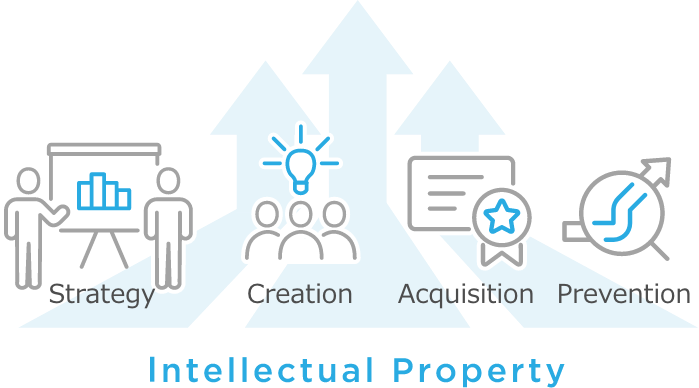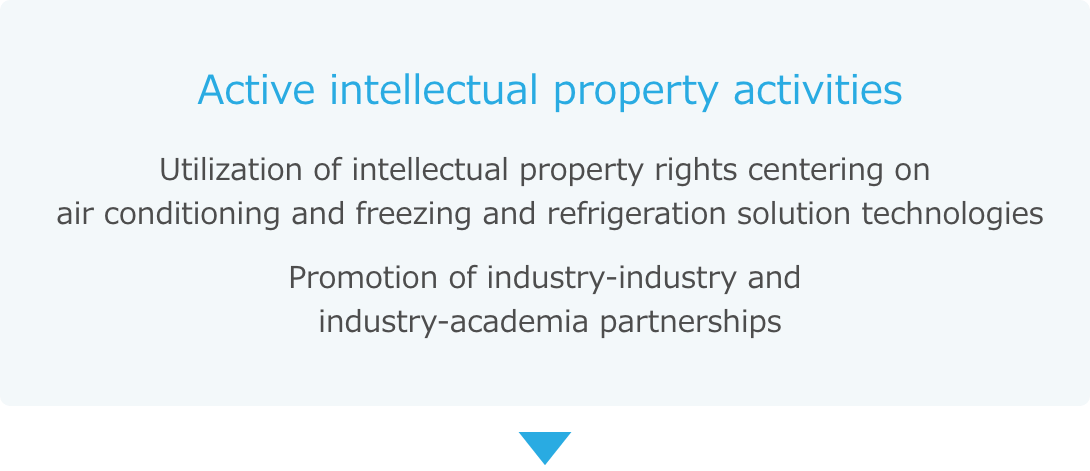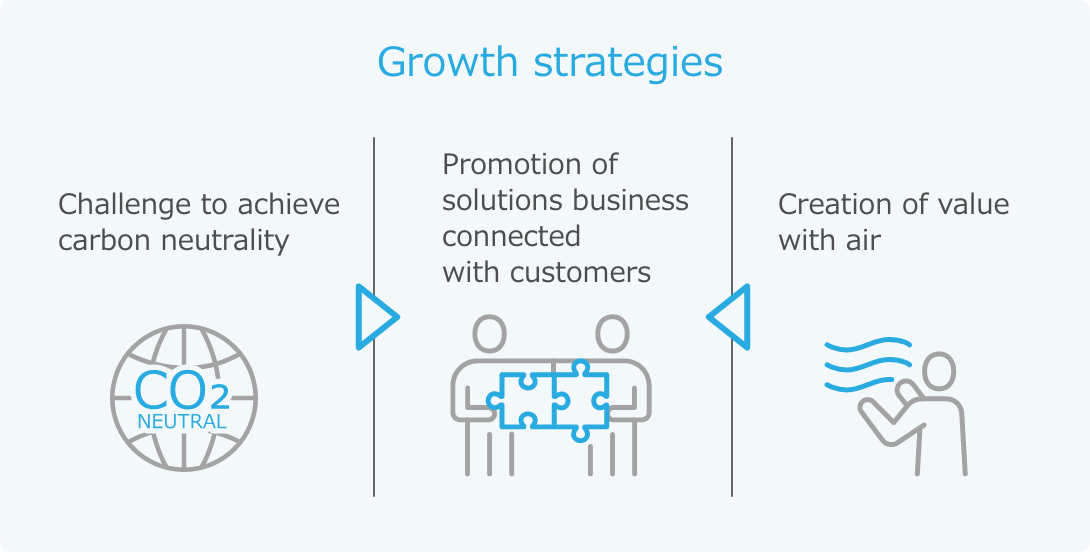Major Activities
- Daikin Industries and Intellectual Properties
- Intellectual Property Activities Contributing to Daikin Business
- Intellectual Property Education System
- Collaboration with Global Bases through the Intellectual Property Operation System
- Open and Close Strategies
Daikin Industries and Intellectual Properties
Daikin understands that intellectual property rights constitute a valuable company asset. We thus strive to both protect these rights and use them effectively to proceed with business. Our Group Conduct Guidelines state that we respect other companies’ intellectual property rights and ensure that our inventions do not infringe on those rights.
Group Conduct GuidelinesBased on the Group Conduct Guidelines, we formulated more detailed points in our Compliance Action Guidelines, which state that we will acquire patents and avoid infringement by having the person in charge of R&D at Daikin be the person responsible for patents and having the researcher/developer understand that he/she is the sole developer of the product or invention.
In new product and new technology development, part of the design review process involves verification that these products and technologies do not infringe on existing patents. In collaboration with other companies, we distinguish between open technologies and confidential technologies, and confidential technologies are designated as such and kept out of reach.
Intellectual Property Activities Contributing to Daikin Business
In addition to the acquisition of intellectual property rights and prevention of infringement of other companies’ intellectual property rights, we contribute to its business through the creation of intellectual properties by industry-industry and industry-academia partnerships, and establishing a network of other companies and researchers through the granting of free access to its patented technologies.
To strategically promote intellectual property activities, we establish and reinforce intellectual property portfolios that contribute to our business in cooperation with the R&D and Sales Departments. We share IP information and the results of market trend analyses with the R&D and Sales Departments as well as top management for use in the development of IP strategies. Furthermore, we also expand IP landscape activities for the establishment of business and IP strategies through backcasting. To disseminate such activities at overseas bases, we promote the establishment of the IP Operation System at individual bases as well as improvement and reinforcement of global intellectual property portfolios.
Promoting the utilization of intellectual properties

Going forward, we will continue to promote the following approaches to achieve the growth strategy themes in our Fusion 25 Strategic Management Plan ending in FY2025: challenge to achieve carbon neutrality, promotion of solutions business connected with customers, and creation of value with air.
-
(1)
Active creation and utilization of intellectual properties on a global scale centering on technologies for energy saving, new-generation refrigerant, heat pumps, air conditioning, and freezing and refrigeration solutions.
-
(2)
Creation and utilization of new intellectual properties, and acquisition of intellectual property rights that support a sustainable future society through the further promotion of industry-industry and industry-academia partnerships.


Intellectual Property Education System
We provide IP education such as e-learning for developers, IP seminars (including practical training) given by IP members at overseas development bases to increase developer awareness about intellectual properties and enhance IP activities.
We also provide trademark caravan, a series of seminars about trademarks, and training designed to meet the needs of individual business departments. This is for employees in charge of sales and marketing at both domestic and overseas bases.
Our domestic IP Department develops skill maps that visualize skills required according to individual employees’ years of experience in intellectual property activities utilizing experience they have accumulated at Daikin, and utilize them as a tool to communicate with supervisors about career improvement. Senior members become mentors for members with less experience and provide OJT depending on individual capabilities and goals.
Intellectual Property Education
| Development Department |
・e-learning ・IP seminars (Domestic / Global) |
|---|---|
| Sales Department |
・Trademark caravan |
| Intellectual Property Department |
・OJT ・Dialogues with supervisors using skill maps ・Support that facilitates the taking of external seminars for the patent attorney examination ・External training (Seminars for certifications provided by AIPE, seminars by JIPA, etc.) ・English conversation lessons ・Interactions with IP members at overseas development bases |
In addition, we help young Intellectual Property Department members take external seminars for the patent attorney examination.
We also promote the acquisition of intellectual property analyst (patent) certification provided by the AIPE and enrollment in English conversation classes to reinforce the collection and analysis of information regarding IPs.
Collaboration with Global Bases through the Intellectual Property Operation System
We also advance the establishment of Intellectual Property Operation System according to the state of individual regions overseas to respond to globalization.
Following the launch of the Fusion 25 Strategic Management Plan, we shared Daikin’s IP policy with our overseas Group companies and began consolidating information from each base. The Global Intellectual Property Meeting has been held periodically to reinforce global IP. We continue strengthening our collaborative system by kicking off meetings in each region as needed.
Open and Close Strategies
We have executed open strategies to achieve both global warming mitigation and business growth.
1. IP strategies for the global expansion of Daikin’s air conditioner with the New Refrigerant R32
ISO Hurdles
The 2016 Kigali Amendment of the Montreal Protocol set the goal of reducing the overall impact of HFCs on global warming by 85%. To achieve this goal, Daikin focused on R-32, whose GWP (global warming potential) is one third of conventional refrigerants. Daikin already had many patents regarding R-32; however, R-32 was mildly flammable and categorized as “flammable.” Therefore, Daikin worked to establish a new category regarding flammability in the ISO involving the entire industry.
Daikin was working on the revision of the ISO safety standards to include the safety standards suitable for R-32; however, many questions about patents associated with R-32 owned by Daikin arose. Daikin then decided to grant free worldwide access to the R-32 patents in a stepwise manner to popularize a refrigerant that contributes to the mitigation of global warming.
First stage of granting free worldwide access to the R-32 refrigerant air conditioner patents
In September 2011, Daikin announced the granting of free access through contracts to 93 patents that had relatively high relevance to the design of R-32 air conditioners. Many manufacturers adopted R-32. To accelerate this, Daikin expanded the countries eligible for free access to the patents to developed countries in September 2015.
Second stage of granting free worldwide access to R-32 refrigerant air conditioner patents
After the first stage of granting free access to R-32 patents, Daikin submitted new patent applications for the R-32 air conditioner. In response to manufacturers worried about Daikin’s exercise of rights for the relevant patents, Daikin granted free access to 176 R-32 patents in July 2019 as the second stage. A further 123 patents were added for free access in July 2021, and 120 patents were added in July 2022.
Effects of granting worldwide free access to the patents
Through such advanced utilization of intellectual properties, Daikin expanded markets and promoted lower GWP HFCs such as R-32, resulting in a significant contribution to the mitigation of global warming. Currently, residential-use air conditioners using R-32 account for more than 50% as of June 2022, and this has been increasing.
Granting worldwide free access to basic patents for refrigerants that contribute to the reduction of the environmental load2. Open strategies for energy-saving inverters
Air conditioner markets in China before collaboration
The ratio of air conditioners containing energy-saving-type inverters was 100% in Japan in 2009; however, it was only 7% in the Chinese market. Daikin anticipated that if this situation continues, energy-saving-type air conditioners would not become the major global trend, and the spread of non-inverter air conditioners from China that ran counter to the global energy-saving concept would allow air conditioners seen as one of the causes of global warming to interfere with the growth of global air conditioner markets.
Strategic collaboration with Gree Electric Appliances Inc. (Open strategy)
Daikin collaborated with Gree Electric Appliances Inc. (China) by licensing its inverter technologies to popularize inverter air conditioners and entice Chinese markets into competition for air conditioners in the high price range, which is Daikin’s strong point.
Close strategies
In fact, although general-use-level inverter technologies were released openly, high energy-saving-type inverter technologies were kept out of reach as confidential technologies.
There were many other points for differentiation other than inverters mounted in air conditioners. For example, besides inverters, we closed the information about technologies for downsizing, noise-reduction, and improvement of comfort and cleanliness to differentiate our technologies.
Effects of open and close strategies
Both market expansion through the establishment of networks based on open strategies and expansion of business profits through differentiation based on close strategies were achieved; and we were also successful in spreading our energy-saving technologies through business collaborations, which we believe significantly contributed to the protection of the global environment.
Initiatives for Intellectual Properties
Find out more in your region.






